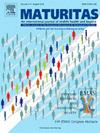日本社区老年人的饮食多样性与多种药物治疗和意外残疾之间的关系:一项纵向研究。
IF 3.9
2区 医学
Q2 GERIATRICS & GERONTOLOGY
引用次数: 0
摘要
目的:本研究考察了在社区居住的老年人中饮食多样性评分(DVS)阶层中多种用药与意外残疾之间的关系。研究设计:对日本爱知县≥65岁社区居民进行前瞻性队列研究。主要结局指标:多重用药定义为每天同时服用处方药物≥5种。参与者被分类为非多药或多药,低、中、高DVS。在对潜在的混杂变量进行调整后,使用Cox比例风险回归模型以95%的置信区间(ci)估计多药组中意外致残的风险比(hr)。结果:纳入5254名老年人(55.7%为女性;平均年龄74.0±5.5岁,平均随访34.7±5.9个月。其中4842人无残疾,412人(7.8%)在随访期间出现残疾。综合用药组的潜在混杂因素调整后的残疾HR为1.37 (CI: 1.07-1.75;p = 0.011)。在分层分析中,低DVS组的多药治疗与较高的事件致残hr显著相关(1.62 [1.11-2.37;p = 0.013]),在高DVS组中,多药与意外致残无显著关联(1.12 [0.74-1.71;p = 0.590])。结论:多药与残疾发生率呈正相关,在低DVS的参与者中效果更明显。与不服用多种药物的人相比,服用多种药物的患者可能有不同的原因,无法获得更多样化的饮食。本文章由计算机程序翻译,如有差异,请以英文原文为准。
Dietary variety and the relationship between polypharmacy and incident disability among Japanese community-dwelling older adults: A longitudinal study
Objectives
This study examined the association between polypharmacy and incident disability across the dietary variety score (DVS) strata among community-dwelling older adults.
Study design
A prospective cohort study with community-dwelling adults aged ≥65 in Aichi, Japan.
Main outcome measures
Polypharmacy was defined as ≥5 concomitant prescription drugs per day. Participants were classified as having non-polypharmacy or polypharmacy and a lower, moderate, or high DVS. Cox proportional hazard regression models were used to estimate hazard ratios (HRs) with 95 % confidence intervals (CIs) for incident disability among the polypharmacy groups after adjusting for potentially confounding variables.
Results
The analysis included 5254 older adults (55.7 % female; average age 74.0 ± 5.5 years) with a mean follow-up time of 34.7 ± 5.9 months. Among them, 4842 remained disability-free, while 412 (7.8 %) developed a disability during follow-up. The potential confounder-adjusted disability HR for participants in the polypharmacy group was 1.37 (CI: 1.07–1.75; p = 0.011). In the stratified analyses, polypharmacy in the lower DVS group was significantly associated with higher HRs for incident disability (1.62 [1.11–2.37; p = 0.013]), and no significant association between polypharmacy and incident disability was observed in the higher DVS group (1.12 [0.74–1.71; p = 0.590]).
Conclusions
Polypharmacy was positively associated with disability incidence, with a more pronounced effect in participants with a lower DVS. Polypharmacy patients may have different reasons for not being able to have a higher variety diet from non-polypharmacy people.
求助全文
通过发布文献求助,成功后即可免费获取论文全文。
去求助
来源期刊

Maturitas
医学-妇产科学
CiteScore
9.10
自引率
2.00%
发文量
142
审稿时长
40 days
期刊介绍:
Maturitas is an international multidisciplinary peer reviewed scientific journal of midlife health and beyond publishing original research, reviews, consensus statements and guidelines, and mini-reviews. The journal provides a forum for all aspects of postreproductive health in both genders ranging from basic science to health and social care.
Topic areas include:• Aging• Alternative and Complementary medicines• Arthritis and Bone Health• Cancer• Cardiovascular Health• Cognitive and Physical Functioning• Epidemiology, health and social care• Gynecology/ Reproductive Endocrinology• Nutrition/ Obesity Diabetes/ Metabolic Syndrome• Menopause, Ovarian Aging• Mental Health• Pharmacology• Sexuality• Quality of Life
 求助内容:
求助内容: 应助结果提醒方式:
应助结果提醒方式:


